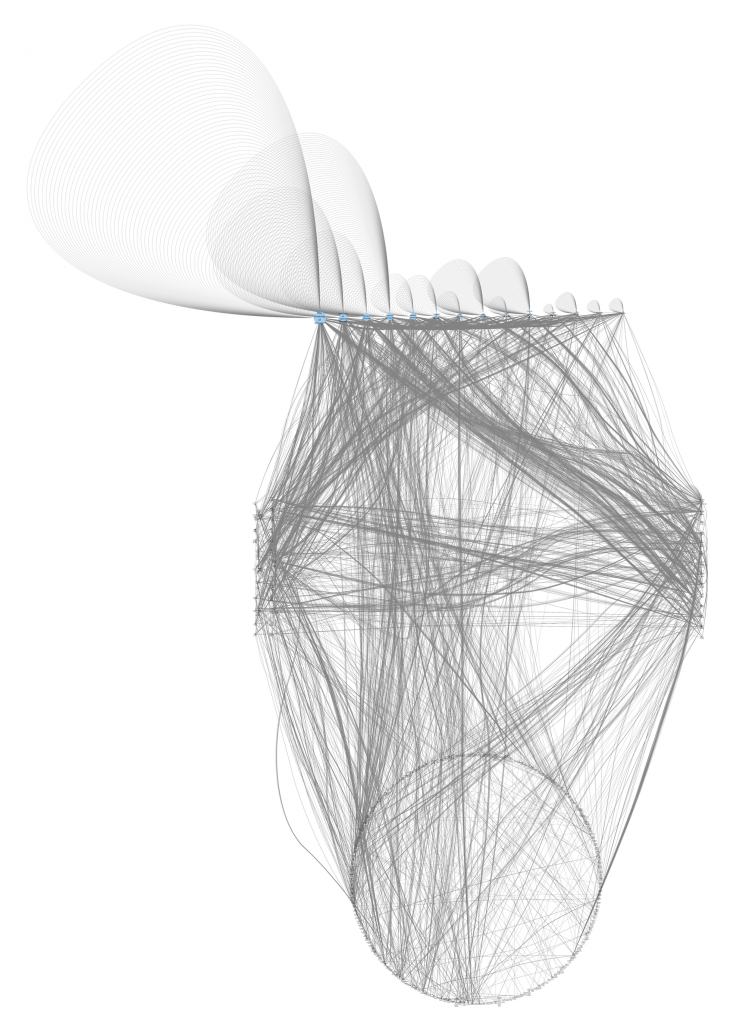Continuing with my recent data experiments, I’ve produced a new graphic which visually displays which anthropology departments in the US (with a handful from the UK and Canada) produce the most graduates, and in which universities those graduates end up. I think of it as showing which universities tend to exercise the most power in defining what counts as cultural anthropology in the US, and in what institutions they exercise that power.
In the graphic below, the blue dots each represent one university. The size of the dot is proportional to the number of dissertations tagged with “cultural anthropology” that university produced. The gray lines connect the institution where the supervisor received their Ph.D. to the institution where their supervisee received their Ph.D. In other words, each line represents one dissertation, and connects the supervisor’s Ph.D. granting institution with the student’s.
This covers the majority of dissertations tagged with “cultural anthropology” (which includes some from ethnomusicology, folklore, and a few other fields) from my ProQuest data, which contains supervisor data for dissertations from about 1988, and institution data to much further back.

The universities are roughly divided into four groups. The group in the vertical row at the top are those with highest number of Ph.D. graduates supervising dissertations in cultural anthropology. This includes the University of Chicago, Berkeley, Harvard, Columbia, Stanford, Michigan, Cornell, Indiana, Penn, UCLA, Washington, UT Austin, Northwestern, and Yale.
The group with the next highest number is the column to the middle-right. This group is notable because it includes LSE, Cambridge, and Oxford, which are the only non-US universities in the top two groups. This is followed by the group to the middle left. This is where our friends in theology and missiology seem to be concentrated. The circle at the bottom are universities which had the fewest number of graduates supervising Ph.D.s, usually zero.
The full-size graphic, where the text labels are all legible and the arrowheads (which show which university is sending a graduate to which one as a supervising staff member) is too large to post, but even with this smaller graphic, it’s possible to see a number of interesting (but expected patterns).
One is the sheer level at which the most prolific universities hire their own. The large fan-shaped patterns coming out of the topmost group are supervisors at those institutions that received their own Ph.Ds at those institutions. These patterns do not hold seem to hold as strongly at other levels.
Another pattern is the density of lateral connections among members of the topmost group. This isn’t unexpected, but it highlights the extent to which if you’ve attended any one of these universities, you’re within a tightly knit community that includes all of them, regardless of your specialization within anthropology.
Perhaps most obvious is the density of connections between the top group and every other group on the map. This speaks to the again unsurprising fact that a certain group of universities will tend to have graduates everywhere, while the majority of other schools will produce PhDs, but tend not to be able to place them within the same field if at all.
Attention to the lines can reveal some things that might be interesting to explore further. For instance, there is a dense bundle of lines between the University of Oregon (in the second group) and the University of San Francisco (in the fourth). This probably comes down to one or two super prolific supervisors, but it would be worth looking to see if there is anything more to the connection. Another similar bundle exists between Cornell and Temple University.
What this particular image doesn’t show well is that some institutions in the “lower tiers” actually seem to have a tremendous influence on the higher ones. This usually goes from the major British universities to the top American ones: LSE and Cambridge especially, but also Oxford. Unfortunately, thesis data for the UK is kept in another database that I’ve not yet had the chance to explore, so I don’t know if this relationship goes both ways. I suspect it doesn’t.
[…] part give me things to think about with regard to my previous post on the structure of American anthropology (emphasis […]
You may be interested in comparing your visualization with that of an article that treated the profession of anthropology as a tribe, with university departments serving as clans that could create ties (and hierarchical relationships) through giving and receiving graduates as faculy (structurally the equivalent of spouses). The results were published as:
Hurlbert, Beverley McElligott. 1976. Status and Exchange in the Profession of Anthropology.
American Anthropologist 78(2):272–284.
At the time, several graduate departments that were showsn to “receive” faculty, but almost never to “give” them, lost nearly all their graduate students.
This is fascinating! Thank you for bringing it to my attention.